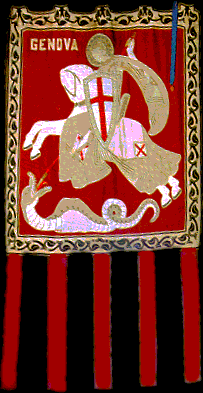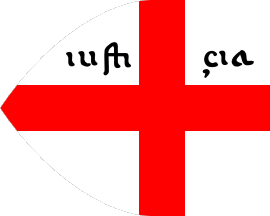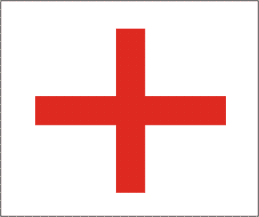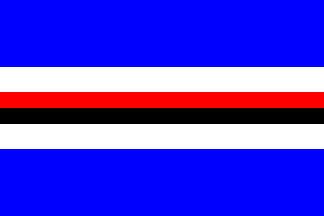
image by Andre' Serranho

Last modified: 2010-02-27 by dov gutterman
Keywords: genoa | genova | republic of genoa | liguria | gryphon | cross | janus | zeneise |
Links: FOTW homepage |
search |
disclaimer and copyright |
write us |
mirrors
See also:
Other Sites:
The first flag of the Republic of Genoa was red with Saint
George riding an horse, attested after 1198. The Republic used in
land after 1218 an white flag with red Saint George cross, later
also used as ensign since 1238. This flag was in use until 1805.
Jaune Ollé, 13 October 1998
Red cross on white field. This flag is listed under number 54
at the chart "Flags of Aspirant Peoples" [eba94] as: "Liguria (Genoa) -
North-West Italy."
AFAIK , Genoa is the capital of Liguria. Lega
Liguria uses more complicated flags, including the red cross
on white field.
Ivan Sache, 6 September 1999
The Statute of the Comune (Community) of Genoa states under
Title 1 - General Principles, point 4:
"The Community of Genova has its own coat of arms, its flag
- both a red cross on a white field - and its gonfalone, prized
with a golden medal for Military Value for the contribute during
the Liberation (in World War II) and it depicts Saint George
killing the dragon."(See: <www.comune.genova.it>).
The story behind this is very interesting. Here follows a brief
summary:
The vexillum beati Georgii (flag of Saint George) is first
reported in the Annales Januenses of 1198 (Genoa Yearbook). A red
flag with Saint George riding a horse and striking a dragon was
the state flag till the first half of the XIII century. A picture
of it appears in the Annales Januenses describing the capture of
the city of Savona in 1227. The banner with four tails is placed
before the Genoa commanders tents and its importance is stressed
by the author, who wrote "vexillum" under it.
Meanwhile, the Community flag, ie the red cross on a white field,
was also used. It is first reported on 28 September 1218: the
insignia cruxata comunis Janue (cross ensigns of the Community of
Genoa) were flying on the city of Ventimiglia, which surrendered
to Genoa. At this point it was a land flag only. It assumed a
modern rectangular shape, with no tails, from mid of the XIV
century. The vexillum beati Georgii is still described in 1241
for the fleet of Genoa, being the war ensign and the Admiral
proper, but in 1242 the signum Communis, ie the cross flag, was
also in use, displayed on the galleys. The vexillum beati Georgii
was flown from the commander (Podesta') galley only. Until at
least 1282 this was the Admiral standard. Today the flag of the
Comune of Genova (Genoa) is still the red cross on a white
background and the Gonfalone is the banner
with the Saint striking the dragon.
Source: Aldo Ziggioto, Genova, in Vexilla Italica 1, XX
(1993);
Aldo Ziggioto, Le Bandiere degli Stati Italiani, in Armi Antiche
1994.
Pier Paolo Lugli, 18 July 2000
I looked up Genua on the flagchart that forms the cover for
Vlaggen - Sierksma, and this shows for 1756 the "Pavillon de
Genes" to be a white flag with a red cross
Peter Hans van den Muijzenberg, 18 July 2000
In 1099 in the first crusade a Genoese fleet conquered some
cities along the coast of the Middle East. The Genoese went then
straight to Jerusalem where they gave a determined help to the
Christian warriors. Guglielmo Embriaco took the red cross up on
to the top of a hill near Jerusalem and said "Pe Zena e pe
San Zorzo" ("For Genoa and for Saint George").
Since that moment the red cross is synonomous with Genoa, even
before it became a symbol of Milan, England etc...
Filippo Noceti, 22 Febuary 2001
I would like to invite everybody to treat carefully statements
of this kind. Crusader flags were the patterns for many following
banners and, eventually, flags, but at the time there was no
concept of flags in the modern way. Aldo Ziggioto works on the
Italian flags are the reference for everybody who wishes to study
the topic.
Pier Paolo Lugli, 22 Febuary 2001
This is the flag of Genoa. Since 1099. It is dark red almost
maroon.
Filippo Noceti, 22 Febuary 2001
Maybe it is true that during the crusades we can't speak of
official flags but the Republic of Genoa was born in 1099 and all
over the Mediterranean Sea a red cross meant Genoa. In 1248 at
the battle of Victoria near Parma the Genoese crossbow-men
conquered the new imperial city. Milan asked to take the red
cross and the allied Genoese allowed them to take the flag. The
Genoese and Pisan fleet cleared the western Mediterraneum of the
Musulman fleet but after 1284, when Pisa was defeated at the
battle of Meloria, and remained the only maritime police (Venice
had been beaten at Corcula in 1297). When the Saracens saw the
red cross they fled and didn't attack. In 1992 for the genoese
columbus festival in Genoa teh Duke of kent have written some
words about the relatinship trough Genoa and England in past
history: "...The St. George's flag, a red cross on a white
field, was adopted by England and the City of London in 1190 for
their ships entering the Mediterranean to benefit from the
protection of the Geonoese fleet. The English Monarch paid an
annual tribute to the Doge of Genoa for this privilege..."
You can find the full text at the site <www.francobampi.it> .
In 1304 Venice took Constantinople but in 1361 the Genoese fleet
helped Michele Paleologo (scismatic Emperor) to take power in the
Eastern Empire, so the trade route to the Black Sea becamed
Genoese and they fortified lots of cities and the cities they
colonized in south-eastern Europe in fact have arms with a red
cross.
Filippo Noceti, 2 March 2001 and 6 June 2001
At J.W Norie - J.S. Hobbs: Flaggen aller seefahrenden
Nationen, 1971[ nor71] (original
print 1848):
197 Genoa- As above.
Peter Hans van den Muijzenberg, 12 November 2001

image contributed by Filippo Noceti, 27 June 2000
Official city gonfalone is this one. The Gonfalone of Genoa
reppresent St. George killing the Dragon
Filippo Noceti, 27 June 2000
The gonfalone of Genoa has the gold medal for the resistance
during the second world war, because Genoese fought for their
freedom by themself.
Filippo Noceti, 19 September 2001

image from <www.araldicacivica.it>
The website <www.araldicacivica.it>
show different gonfalone.
Eli Gutterman, 10 November 2005
genov.jpg)
image contributed by Filippo Noceti, 8 June 2001
The symbol of the city of Genoa is with Griphons, St. George
cross and at the top Gianus the roman god with two faces, the
Roman god of Genoa.
Filippo Noceti, 22 Febuary 2001
The god is usually spelled Janus in English.
Ole Andersen, 22 Febuary 2001
At the base, on the both, there is the spur of a roman
allegoric ship whith the snout fo a wild boar.
Filippo Noceti, 8 June 2001
I believe he meant a Roman ship with a boar's head figure on
the bow. I cannot see enough detail to confirm it, but suspect
Filippo is referring to the small embellishments upon which both
griffin supporters are resting a paw.
Ned Smith, 8 June 2001
There is an error in my previous text. . The spur is a real
thing that have been found in 1597 in the Gulf of Genoa and it's
really a part of a roman ship, it isn't an allegoric picture. Now
it's in Turin in a museum, Savoia taked it during their reign.
You can see this image on lot of genoese monuments, like the
monument to Columbus, the Triumphal Arch builded after 1st world
war or on the paint of the admiral Andrea Doria. At <www.fotodigenova.com/acquaverde6.html>
you can see them all around the rounded base of Columbus munumet
and at <www.fotodigenova.com/piazzavittoriasf.html>
on the top at the level of arch in the corners. You can see it at
the site of the Gallery of Tourin <members.it.tripod.de/~gat/collezione.htm>.
Filippo Noceti, 22 June 2001

image by Eugene Ipavec, 24 December 2009
The 26th flag mentioned and illustrated in the Book of All
Kingdoms [e9s50] is attributed to
Génova (usual Spanish form of Genoa). This as depicted in the
2005 spanish illustrated transcription [e9s05], a white flag with a red cross
throughout, reading "iustiçia" in balck letters
accross the the upper half; the flag shown in the ogival default
shape of this source.
The anonymous author of [e9s50]
describes the flag thusly: "El seńor della á por seńales
un pendón blanco con una cruz bermeja. Encima está escripto
«Justicia» d’esta manera" (And its lord has for sign
a white pendon with a red cross. Atop it is written «Justicia»
like this.).
The lettering reads rather "iustiçia", set in black
uncial (lower case) letters, with dotless "i",
so-called long "s" ("ſ"),
unorthographic cedilla, and ligated "sti", with
"iusti" on the upper fly quadrant and "çia"
on the upper hoist.
António Martins-Tuválkin, 15 November 2007

image by Jaume Ollé, 11 April 2003
No. 430 - Duchy of Genoa.
Source: [stb62]
Jaume Ollé, 11 April 2003

image by Jaume Ollé, 8 June 2003
No. 649 - Genoa.
Source: [stb62]
Jaume Ollé, 8 June 2003

image by Jaume Ollé, 15 June 2003
No. 692 - Genoa.
Source: [stb62]
Jaume Ollé, 15 June 2003
Anyone knows what is the language that is represented by a red
St. George cross on white at <www.acompagna.org> ?
It is probably connected with Genoa or Liguria since it looks
like some coltural organization from Genoa. Their gonfalone at:
<www.acompagna.org/gonfalone.htm>.
Dov Gutterman, 11 July 2001
The word "zeneise" maens citizen of Genova in the
local language of Genova. The red cross on a white background is
the flag (vexillum) of Saint George, a saint which Genova is
devoted to. This flag was adopted in the age of the first Crusade
and lately England was allowed to use it by the Republic of
Genova.
This is a short story. You can find a longer explanation (in
English) at my
pages.
Franco Bampi, 12 July 2001
In the Liguria Region is spoken as native tongue a language
called "Ligurian" that, I think, was also the official
language of Genoa Republic.Zeneise is the local dialect of this
language spoken in the city of Genoa and is the main dialect
of this language, it's like a standard ligurian.
Edoard Salza, 12 December 2001

image contributed by Ivano Piermarini, 21 January 2004
“A compagna” is the Association of the Genovesi
loving of Genoa and their ancient land, the ancient glories, the
beauties, the traditions, the language and the customs of their
People, beside and above every political and religious faith. In
the front part it represent Saint George (patron of Genoa and
protecting of Liguria), in steel armor. In the posterior part it
represent the figure of the “Grifo” and the coats of
arms of the eight Compagne
Genovesi: San Lorenzo, Piazza Longa, Sozziglia,
Portanuova, Borgo, Castello, Porta and Maccagnana. In the Middle
Ages, the noblest and rich citizens of Genova organized
themselves in consortia of families that lived in the
same contrade and that they had common interests. Such
consortia were named compagne.
See: <www.acompagna.org>
and <www.francobampi.it>.
Ivano Piermarini, 21 January 2004
The flag of the
Genoa Cricket and Football Club1893 is red and blue.
Corrado Mortelli, 21 February 2006

image by António Martins-Tuválkin, 15 September 2005
I saw this morning in the Lisbon airport the arrival of a
large and noisy party of soccer supporters from Italy. I think
they are Sampdoria fans . Some of them had flags, apparently
mass-manufactored, matching other fan gear: Medium blue with a
wide central white stripe and and thinner red and black stripes
on it. Approximate specs: (9+3+2+2+3+9):42 = 2:3.
António Martins-Tuválkin, 15 September 2005
It is the Sampdoria flag. It is Italian football club of
Genoa, founded by the merger of two minor club in the Genoa area:
Sampierdarenese and Andrea Doria.
Paolo, 15 September 2005
I believe you might be interested in one small (very big
to a Genoese) detail about Sampdoria football club: It is not a
team from a suburb of Genoa but it is a team founded in 1946 by
the fusion of two exsisting teams: one was the Sampierdanerese
(which means "from Sampierdarena, a popular industrial
neighborhood of Genoa) the other one was the "Andrea
Doria" which is as Genoese as you can get (the name was
taken from the famous admiral). The name was indeed Samp + Doria
= Sampdoria. It is a football team founded by teams
well rooted in Genoese tradition. On the contrary
"Genoa Cricket and Football Club"
was founded by British citizens in Italy and won all of the
championships with a team completely made by British citizens. It
is now part of the blood and DNA of town, of course.
Paolo Tavella, 15 March 2006